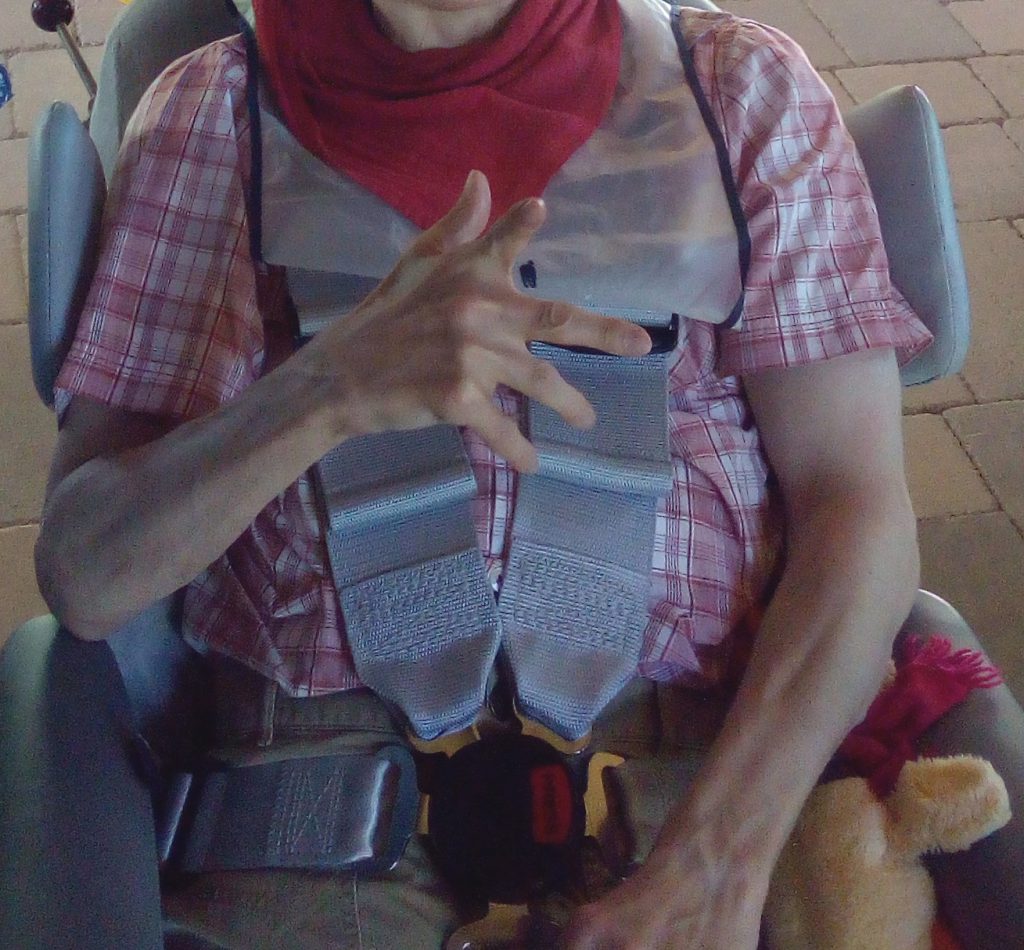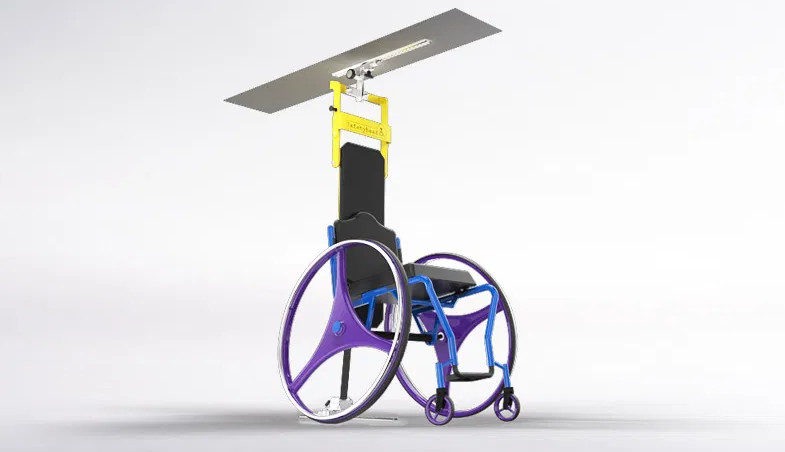This post is also available in: Nederlands (Dutch)
A wheelchair should fit like a glove!
In order, as a wheelchair user, to be able to function as optimally as possible functional requirements are drawn up for each wheelchair provision, which a wheelchair should meet. An inappropriate wheelchair can have major consequences for the physical condition of the user and therefore in education, being able to work, sports and other daily activities.
Therefore, in many cases these requirements are drawn up together with an occupational therapist. It may mean that a standard factory wheelchair needs to be adapted to meet the requirements package, or even providing a custom wheelchair fully individually adapted to one wheelchair user.
In the Netherlands, that glove is now in danger of missing fingers.
In addition to these benefits, other factors for manufacturers count in the placing of wheelchairs on the market. Competitiveness, product liability, comply with the Medical Device Directive (from 26 May 2021 the statutory Medical Device Directive harmonised in the NL Medical Devices Act). Product risks, the recognition of possible dangers play an important role in this.
Each manufacturer makes his own risk analysis for each product. Risks are solved as much as possible with product modifications. What are the acceptable residual risks? And does the manufacturer consider these risks to outweigh the benefits of the wheelchair in question for the user group for which it is intended? The intended use and risks are recorded in a risk management document. Communication with the user is done via the manual and/or a separate instruction.
A number of manufacturers have responded to the MDD/MDR by restricting the intended product use, for example by deeming a wheelchair not suitable for use as a passenger seat in a vehicle. Also, the intended use of the wheelchair and/or the accepted adjustments are sometimes limited.
When adapting such a wheelchair to the functional capabilities of the user, the use of this wheelchair outside the intended use by the manufacturer may be necessary for the provision of a suitable wheelchair. Then the adjustment company/adjuster of the aid supplier suddenly becomes a manufacturer!
As a manufacturer, the fitting company is fully responsible for the product. This means quite a lot in the context of the MDR, because the manufacturer must therefore have the complete risk management document. This can only be done with the cooperation of the original manufacturer.
As a result, wheelchair users have to deal with device suppliers who say, ‘that adjustment is not allowed by the manufacturer’. This may result in a less suitable wheelchair being provided. This process also has consequences for solving certain security situations.
Practical example 1
A wheelchair with a low backrest can serve as a passenger seat if there is a back and head support in the vehicle. The problem with this solution is that the wheelchair manufacturer will usually characterize the wheelchair with a low backrest as not suitable as a passenger seat. If those wheelchairs are not considered transportable, taxi companies/ bus conversion companies will hardly be willing to invest in such back and head support for cost reasons. And manufacturers of back and head support have a problem finding a market.
Safetyhead as an example for head and back support,(www.ambulanzmobile.eu)
As a result, possible solutions remain on the drawing board. As a passenger in the wheelchair, the wheelchair user will have to opt for a less suitable model with a high backrest and headrest, which get in the way of manual driving the wheelchair.
The glove will miss fingers!
Legal rules can put pressure on finding solutions. There is a tendency to regulate everything from above to the point and comma in regulations, covenants and boarded-up liabilities. An example:
I remember from the time when the ISO 9000 was first introduced, when my colleagues and I imposed a pretty strict structure on our lab in response, ignoring the fact that lab staff can make a professional assessment themselves and often know very well what works and what doesn’t. This resulted in a lot of paperwork to be held accountable, which also had to be audited. And very frustrated lab employees if there was “a check mark wrong”. In a second version ISO 9000 documentation, a lot was deleted and there was more emphasis on the content of the profession, training requirements and the own responsibility of the lab employee. That worked well, while still meeting the ISO 9000 standard.
In general, when drawing up legislation and safety standards, a consideration is made about the level of safety, the risk in relation to the social costs of safety measures.
Criterion in medical devices is to weigh the management of risks against the purpose and benefits of the product for the user. This consideration has become an essential part of nen-en-ISO(s) 14971 Medical devices – Application of risk management for medical devices (ISO 14971:2019) This standard is cited in the MDR.
“Benefit:
positive impact or desirable outcome of the use of a medical device (3.10) on the health of an individual, or a positive impact on patient management or public health”
citaat NEN-EN-ISO 14971:2009
Transport of wheelchair passengers.
1. When authorising cars to the road, they shall meet a variety of requirements, including crash tests with instrumented dummies forward, backward, sideways and obliquely from the front to increase the survival of the occupants. The belt loop is also precisely defined, because the seat position can be easily determined. In addition, there are airbags for a higher level of safety. Despite all the measures, absolute safety is not feasible. Passengers and drivers are still dying as a result of accidents.
2. In the case of wheelchairs as a passenger seat, of all these crash test requirements only forward impact safety remains, tested with a non instrumented dummy. The effects on the head and neck injuries are known only very limited. The wheelchair stays up as well as possible but how is the occupant coping?
The argument behind this is that the social costs of a wheelchair design that would meet all automotive admission standards are enormously high, with the wheelchair in other daily use also no longer meeting the functional need. Hence the call that, if you can get out of the wheelchair, transport in a fixed seat is safer. However, the caveat is that that seat, designed for a ‘standard’ passenger, must provide sufficient support for wheelchair users. Quite a few wheelchair users cannot make that switch or only with very great effort. The trade-off is then a potentially higher risk in the event of an accident against the functional disability (fatigue) that switching seats results for the rest of the day.
Finally, the number of transport kilometres is often lower for this group and the type of car (wheelchair bus) also affects the conditions during a crash. The situation is therefore not easy to grasp in one simple rule.
A similar step applies to wheelchair users who, due to their disability, cannot use a wheelchair that fully complies with ISO 7176/19, because they use a custom wheelchair.
From reactions to my open letter from VWS and the VNG, it has become clear that the solution to be transported alone (with possibly a companion) in a taxi bus entails too high social costs. Both VWS and VNG refer to the consultation with the stakeholders code VVR at the Ministry of Infrastructure and Water Management. It is also clear that an “appropriate inclusive solution direction” is expected from the consultations at the Ministry of IW.
3. In my opinion, the next step is clear. Ensure the safest possible solution. Due to the diversity of this group, they have a custom wheelchair for a reason, that means devising and looking for individual solutions close to the workplace.
Support the manufacturer of custom wheelchairs, the occupational therapist and the device advisor in finding the safest possible solutions in relation to the functional requirements and the known risks, in consultation with the user. Also involve these people in the stakeholders (safety) consultation and regulations. Let them indicate what works and what doesn’t.
Research which solutions are already found/used, and share that knowledge, including in training. It is important that the safety weighing is an integral part of the supplying process. From the first visit of the aid advisor on. When producing the wheelchair, for example, seat belt use in the wheelchair bus can be taken into account and, if that is a better solution, a safety belt integrated into the wheelchair.
Only at the end to think about whether and how a WTORS can be used in a taxi bus with an already delivered custom wheelchair, as is often the case now, yields less good solutions and possibly even unsafe situations.
I think it makes sense to use examples together with the manufacturers of custom wheelchairs to think about these solutions and the supplying process. What is possible and what risks are there. In the end, it is the manufacturer, who, after careful consideration, indicates that the wheelchair can be used as a passenger seat in wheelchair transport. If the supplying process – with the weighing of safety aspects, functional requirements and financial preconditions of the client – has gone well, this results in the safest possible wheelchair.
By capturing the chosen balanced solution in a wheelchair passport, it is also clear to the driver what is expected, for example with regard to the securement in the wheelchair bus.
Practical example 2
In addition to the example mentioned above, such a practical example could also be my son’s last wheelchair, using a race seat belt in the wheelchair as a combination of seat belt and seat position support.

See: opens in a new windowhttps://troostoverleven.nl/2020/10/gastblog-roelof-veenbaas-arjen-de-code-vvr-en-veilig-rolstoelvervoer/
I’m sure there’s still something to improve on, but at that time it was the most safe and functionally feasible solution. The use of such a seatbelt system could be covered by Article 59(4)(c) of the RVV. There are sufficient starting points in the different ISO standards to make this possible where regulations could offer the preconditions to allow a good trade-off for custom wheelchairs. Give manufacturers the space they have within the MDR.
To get back to my ISO 9000 example I started with. In the Netherlands there are manufacturers, resource advisors, occupational and physiotherapists who specialize in providing and supplying tailor-made wheelchairs for wheelchair users with a complex care demand. These professions now have to deal with the MDR and can make good use of the support in finding workable solutions, including from Firevaned and Social Mobility Fund! My fear is that the focus of the MDR is mainly on limiting liabilities, on what is not allowed. That this group gets the feeling of not being appreciated, because they are not supported in what following the MDR is allowed and could be done well. Experts in this field will then disappear. This means that solutions for the aforementioned group of wheelchair users will disappear.
Making a suitable custom wheelchair available takes longer, or even becomes impossible. This has quite a lot of social consequences for work and daily activities of users of a custommade wheelchair. This can be avoided if the group in the workplace is involved in solutions to comply with the MDR. I’d welcome that. Enable an open discussion in the workplace, and offer perspective on solutions.
My approach is to realize the accessibility of transport for all wheelchair users in the safest possible way. “Transport safely or not transport” then changes to “Transport safe”!
My question: According to the stakeholders of the Code VVR platform, is this approach also feasible?
I am happy to enter into an open (digital) consultation together with others. I would appreciate it if the conclusions of this would become more widely available than just for the stakeholder code VVR deliberations.
I have mentioned some examples where theory and practice do not find each other. I would like to appeal to wheelchair users and professionals on the work floor to send me more examples where the wheelchair misses fingers as a suitable glove. So that solutions can be searched and found.
Ir. Roelof Veenbaas
roelof@arenlezen.nlcreate new email
P.S. Why am I committed to this? My motivation is in line with that of Marjolein Quené,
See: Today’s boss follows a step-by-step plan and therein lies a danger.


Oh Roelof! We are so much on the same page. What we see here is the gap between Regulation and Practice, when it comes to safety in transport. Risk Management covered by EN ISO 14971 is all about risk management from a manufacturer perspective. The accepted standard underpins the actions to be taken by the manufacturer at design and test stage, and it is good, used in conjunction with ISO 13485 Quality Management Systems for Medical Devices – it’s as good as it gets. As you say – what happens at prescription stage – the addition of those additional items to support the individual user, not just from a posture respect but medical support devices and communication systems. Who underpins those essential decisions – who is going to deny access to transport – access to life? Dangerous territory, and we all know where that can lead us. I’m with you Roelof.
Thank you Robert for your supporting reply,
You manage to summarize the problem to the essential core.
I have been reading the Checklist manifesto by Atul Gawande lately. There is an example in his book how in the construction world problems are tackled by experts from the all departments involved in a complex high tower flatbuilding project. If a problem arises (a concrete floor getting lower in the middle) in an expert meeting from all construction departments, a solution is proposed and discussed and a solution has to be agreed on by all present. It has to happen in time, because the problem can´t wait.
You just made me thinking in the direction of a good solution. Maybe this is a solution direction here too. A wheelchair manufacturer generally might not allow some combinations, but in a specific case might agree that there is no other solution available. If all parties would agree to that solution and sign off on the solution, we would have made great progress. It requires parties which trust each other and build on each others expertise.
The solution cannot be directed to a few external experts who would be fully responsible for the wheelchair, just because of the liability issues. Each expert has his/her limitations, I do know my limitations on the knowledge of wheelchair manufacturing. It has to be a joint decision by all manufacturers and adaptation engineers working on the devices used in the particular wheelchair. And once structered well and put into practice, it has to and can also happen fast! We could use the checklists in de BPG, and continue to improve them in time during the application.
My base is
1. Everybody should be able to use transport
2. The situation should not get worse due to the MDR
3. Wheelchairs need to be provided on time (this discussion should not delay provision of wheelchairs).
And it would be nice if this would become a common EU solution.